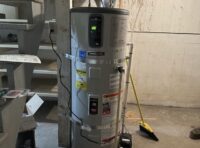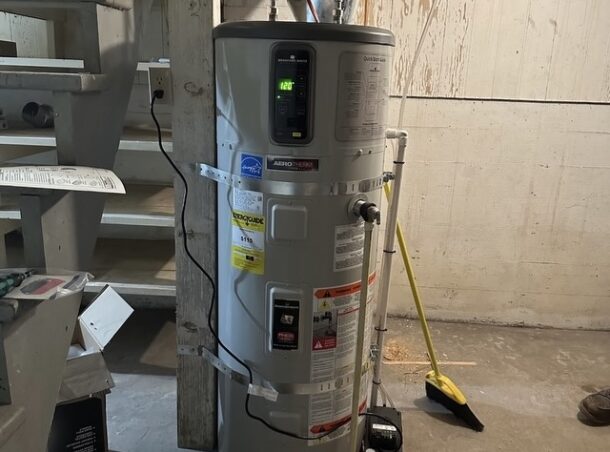https://vimeo.com/1063068523 On this week’s update, we’ll talk U.S. infrastructure and what the current state of that looks like, World Plumbing Day, we’ll feature some of our AHR visits and a new contractor spotlight with Shawn Ziegler, Accurate Mechanical out of Lancaster, Ohio. Plus, we’ll talk new, weekly podcasts. Oh, and I almost forgot, Gate Lice Read more
heat pump water heaters

On this week’s update, we’ll talk U.S. infrastructure and what the current state of that looks like, World Plumbing Day, we’ll feature some of our AHR visits and a new contractor spotlight with Shawn Ziegler, Accurate Mechanical out of Lancaster, Ohio. Plus, we’ll talk new, weekly podcasts. Oh, and I almost forgot, Gate Lice.

https://vimeo.com/1056462403 A quick AHR recap: From sunny and 85 degrees to back to reality with 4 inches of snow and 15 degrees. While at the AHR Expo, we visit with Milwaukee Tool, Uponor and Bradford White. This Weekly Update is powered by our partners at Milwaukee Tool Read more
A quick AHR recap: From sunny and 85 degrees to back to reality with 4 inches of snow and 15 degrees. While at the AHR Expo, we visit with Milwaukee Tool, Uponor and Bradford White.
This Weekly Update is powered by our partners at Milwaukee Tool.

https://vimeo.com/1043475838 Can you believe we made it to 2025? This week we’ll talk AHR, because don’t look now, we’re a month out from the biggest industry event of the year. We’ll also talk hoarders or a messy work areas in a customer’s home. And, of course, new podcasts, which drop every Tuesday. Weekly Links Read more
Can you believe we made it to 2025? This week we’ll talk AHR, because don’t look now, we’re a month out from the biggest industry event of the year. We’ll also talk hoarders or a messy work areas in a customer’s home. And, of course, new podcasts, which drop every Tuesday.
Weekly Links:
Solar-powered Evaporative Cooling
Solar-powered Evaporative Cooling Tower, Another Weapon in the Arsenal to Reduce Energy Costs
Heat Pump Water Heaters
When Hoarders Strike?
https://www.instagram.com/p/DENJ69YR7_U/
Podcasts

https://vimeo.com/1038401163 Welcome back to our weekly update. Another Friday the 13th? Oooph. I hope everyone gets through the day without any black cats, walking under ladders, you know the drill. What are you superstitious about? We hope you have a great day, nonetheless. On this update, we’ll talk heat pump water heaters, the effects of Read more
Welcome back to our weekly update. Another Friday the 13th? Oooph. I hope everyone gets through the day without any black cats, walking under ladders, you know the drill. What are you superstitious about? We hope you have a great day, nonetheless. On this update, we’ll talk heat pump water heaters, the effects of potential tariffs from the new president, and our new podcasts.

I was talking the other day with my buddy who lives northern Wisconsin on the topic heat pump water heaters (HPWHs). You see, he is in the market for a water heater and was asking my advice on those particular units. Wanting to know more myself, I pulled up some info and the more in-depth Read more
I was talking the other day with my buddy who lives northern Wisconsin on the topic heat pump water heaters (HPWHs). You see, he is in the market for a water heater and was asking my advice on those particular units. Wanting to know more myself, I pulled up some info and the more in-depth I got, the more I wanted to know. Cold weather performance, special ducting, size of mechanical space, accessibility to air, cooling and conditioning of adjacent space are all very important topics of discussion.
But, wait a minute, I thought to myself, I can use some of my “superpowers” as an editor in the trades these past 20+ years to ask people who are more in the know about HPWH than me.
I recently reached out to few people I trust to give me honest assessments of these units.
Advantage Heat Pump Water Heaters
According to Eric Aune, Aune Plumbing, Heating & Drains, there has been a ton of marketing to the public, and even more incentives for installation. “Local utilities are offering rebates upwards of $2-3K in some places, and here in Minnesota, we aren’t seeing rebates that high but it’s clear why the rebates are offered—because its lowering and spreading the load on the grid over longer periods at lower consumption rates. The utilities are trying to stay in front of or (most likely) catch up to the growing demand and stress on the grids all across the country. HPWH’s are one piece to the puzzle.”

John Siegenthaler, P.E., Appropriate Designs, gives three bona fide advantages for HPWHs: One, they are excellent for capturing “surplus heat” (e.g., heat that’s present but not generated by another heat source for the purpose of warming the space). For example, solar heat gain to a garage, or heat generated by computer servers. Two, when properly applied, they can generate a given amount of DHW on about 1/3 the electrical input required by a standard “resistance type” electric water heater (tank or tankless). And three, some models are available that can operate on 120 VAC power, whereas all electric resistance water heaters require 240 VAC power.
But in Cold Climates?
But are these units considered more inefficient the more you climb the northern latitudes to colder climates? “Although heat pump water heaters are often placed in unconditioned spaces such as garages in southern locations, it would be a big mistake to do so in a cold northern climate where outside temperatures are below the minimum operating air temperature for the HPWH for weeks or months during winter,” says Siegenthaler. “The heating performance of any air source heat pump—ductless, central, air-to-water, HPWH, always decreases with decreasing air temperature—Putting any water heater in a cold space is not recommended. Standby heat loss would definitely increase.”
HPWHs have minimum air flow requirements, especially if placed in confined spaces, adds Siegenthaler. The I/O manual supplied with the unit should give all these requirements. “Some units allow ducting of outside air to the heat pump assembly on top of the tank, but I would only use this option in a relatively warm climate. Using ducted outside air also foregoes the cooling and dehumidifying benefit of the HPWH,” says Siegenthaler.
Living in Minnesota, Aune says, “HPWH’s capture/transfer the heat in the space surrounding them to the tank of water. When you talk about this here in Minnesota, it’s common for people to consider this inefficient since the we have to heat with a boiler or furnace, so aren’t we running our space heating system to provide heat for the water heater?
“The reality is the HPWH is able to capture and transfer a lot of energy without major negative effects on the conditioning and comfort of the space with a few considerations like ducting the less humid, colder air to the exterior of the house or even moving it with the furnace or exhaust fans,” says Aune.
According to Gary Klein, principal, Gary Klein and Associates, the majority of HPWHs sold today are hybrid HPWHs, and their efficiency is rated at 67.5 F and 50% relative humidity. “Very close to the temperature we keep the inside of conditioned buildings,” says Klein.
Klein suggests an interesting concept by managing the cold discharge air. “Install the HPWH in the basement near the space conditioning system. Use the return of that system to suck in the cold discharge air from the HPWH and distribute it throughout the house. Use a relay to link the fan to the HPWH. Let the thermostat decide if the air needs to be conditioned. Install a very large filter grille to bring air to the room where the HPWH is installed. (2-inch pleated filters).
“Need the ability to move at least 60 cfm per 100 watts of compressor, fan and control power. Warmer intake air increases the coefficient of performance (COP),” says Klein.
Siegenthaler points out that he did a column earlier this year that discussed a situation where a modern house used an air source heat pump for space heating, and combined it with a HPWH inside the house for DHW. Technically this puts the two heat pumps into a “cascade” relationship, says Siegenthaler.
“Think of the space heating heat pump as ‘feeding’ heat to the HPWH. It’s possible to show that the overall efficiency of this arrangement is lower than using a single air-to-water heat pump for both space heating and domestic hot water (DHW). I think that this is important because many builders, architects, energy planners, energy auditors, etc. don’t necessarily understand this concept. They assume that two heat pumps—one for space heating, and the other for DHW—are better than one.”
Siegenthaler stresses that the “ideal” scenario for a HPWH is to put it in a space where there’s “surplus heat.” “Don’t rob Peter to pay Paul,” says Siegenthaler.
There are plenty of such spaces, suggests Siegenthaler, especially in commercial buildings—manufacturing, heat from vending equipment or refrigeration equipment, cooking, laundry, computers, solar gain, attics that remain above 35ºF year-round, even mechanical rooms with lots of uninsulated piping, boilers, electrical transformers, greenhouses, cannabis grow houses, etc.
“Paraphrasing Patrick Henry, ‘Give me air, or give me death,'” says Klein.
